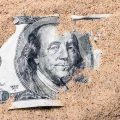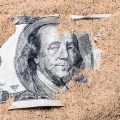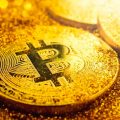When a fiat currency dies, it initially promotes deflation (because in the face of uncertainty,the value of money increases), but then acceleratesinflation, which ultimately goes into hyperinflation. And Bitcoin was designed with that in mind. This post is a translation of the tweet thread of Robert Breedlove, CEO of Parallax Digital, in which he shares his vision of the macro perspective of the US dollar.
Economic uncertainty todayextremely high. Market participants accumulate dollars to insure against this uncertainty, consumers put off optional and large purchases. Such behavior further inhibits economic activity in a consumer-oriented society, further enhancing the economic consequences, uncertainty, etc. in a spiral. Political reactions are becoming increasingly uncertain (so much so that the economic policy uncertainty index sets new highs):


Monthly global economic policy uncertainty index.
Already now the number of employed US citizenssmaller than ever in this century, and continues to decline rapidly. This excludes marginalized workers who have reduced hours of work or wages.


US unemployment rate from 1948 to 2020
It should also be borne in mind that over the past 20 years, the US population has increased by more than 50 million people, and property inequality has increased dramatically.


Combined with high international demand fordollar, these factors lead to a reduction in costs and the strengthening of the US dollar: such favorable conditions are a strong incentive for the Fed to continue to print money. My opinion is that the Fed will overestimate the prospects and, spurred by international demand for dollars, will release an excessive amount of them (since it has both a precedent and an incentive for this). In this case, the dollar may go to the early stages of hyperinflation by 2022.
By 2022, US government spendinginterest and mandatory payments will ultimately go beyond tax revenues, and this will force the government to print money already to pay for its obligations, which historically has been the first stage of hyperinflation.


Expenditures, revenues and tax expenses in 2020. Tax expenditures, which are projected to be $ 1.8 trillion in 2020, reduce government revenue and, like spending programs, contribute to deficits.
Some do not consider inflation a threat due to deflationary conditions after the Great Recession of 2008, but the current economic shock is different from the previous ones.
In 2008, the economy did not experience this.supply reduction, only a reduction in demand due to collapse of credit markets. In 2020, gaps in global supply chains occur everywhere - from auto parts to meat products - things become more scarce.
Thus, although the demand for dollar reserves ishow to protect in conditions of uncertainty - now it’s high, it creates potentially dangerous conditions in which the policy of “quantitative easing” pursued by the central bank does not cause immediate negative consequences.
But when the limitations caused by the coronaviruswill be completely removed, consumer demand will return in the conditions of a significant decrease in the level of supply, and prices will begin to rise - first gradually, and then more and more accelerating due to the abundant injection of additional liquidity into the economy. As prices rise faster and faster, the purchasing power of the dollar will decline, and people will seek to buy something whose supply cannot be “quantified” by someone.
We have already seen a jump in the price of uranium exclusivelydue to supply restrictions. What happens when such leaps are reinforced by the fact that a growing number of dollars will chase a decreasing number of things?


Since the beginning of 2020, uranium has grown by $ 9.35, or by 37.63%, according to the bidding on the CFD.
It may take many years before the development of hyperinflation, however, in my opinion, this crisis will develop in 3 stages.
PHASE 1: With the return of demand, we will find that for the first time in decades, we lack the production capacity (due to the rupture of supply chains) to satisfy it.
PHASE 2: Nation states will respond to this recession in trade, emphasizing the interdependence of all economies in the world, (stupidly) insisting on increasing the isolation and self-sufficiency of their country's economy and strengthening protectionist measures.
This will create additional pressure on trade,will have a negative impact on labor productivity and productivity. The weakening of the deflationary pressure of globalization over the past few decades will be unprecedentedly painful for prices.
Declining inflation since 1980 peak coincides withChina's discovery of its economy and its adoption as a world production center; reversing this process will erase the results of a 40-year deflationary trend.


PHASE 3: Starting too late to fight inflation, central banks will float the last arrow in their quiver and raise interest rates, which (not surprisingly) were reduced to near-zero after abandoning the gold standard.


US federal funds rate
This will increase the cost of capital for companies, andpart of this growth will be passed on to consumers through higher prices, which will further exacerbate dollar inflation. Situated between the notorious “hammer and anvil”, the Fed will sooner or later lose control of the situation, and the dollar will go into hyperinflation.
a.You want to insure against the risks of deflation andinflation. Keeping US dollars safe in the short run, but in the long run, the best bet is hard money and good commodity assets. For instance:
- Gold (not silver)
- Uranium (nuclear power is one of the most efficient forms of energy production)
- Bitcoin is the most scarce liquid asset in the world, virtually invulnerable to any government action.
b.Stock market price signals in the course of the processes described here will beIn addition, governments willseek to tax and control everything that is possible, so corporations will face serious fiscal and regulatory hurdles.
Do not try to accurately calculate the transition timefrom deflation to inflation - there will be many false signals along this path that will seem obvious only in retrospect. Short-term positions are best translated into a hedge against deflation, and long-term ones into a hedge against inflation.
And only Bitcoin can act as a hedge at the same time against deflation and inflation:
- Deflation:Bitcoin's exponential deflation will always outpace the dollar's deflation.
- Inflation:Bitcoin was created specifically to counter "accommodative monetary policy."
Property rights will be compromised,as governments will nationalize real estate, confiscate money, and seize whatever is possible. If the American dollar collapses, the model of nation states in the form in which we know them will also be engulfed in fire.
And while it is burning, it is important to remember: there is only one monetary unit in the world with indisputable ownership - Bitcoin, and it has every chance of becoming the most valuable asset in the world plundered by its governments.


We live in an amazing time! Digital technologies are changing the rules of the game in almost all areas of life. Compared to Bitcoin, even gold is not safe ...
Take care of yourself. Stay humble. Save up Satoshi (in the name of security).
</p>





